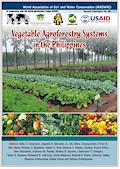| Book Chapter |
 |
|
| Title | Tree and Vegetable Management under Vegetable-Agroforestry System | | Author | Agustin Mercado, Jr., Caroline Duque-Piñon, Manuel Reyes and Manuel C. Palada | | Editors | Delia Catacutan, Agustin Mercado, Jr., Ma. Elena Chiong-Javier, Victor B. Ella, Victoria O.Espaldon, Agnes C. Rola, Manuel C. Palada, Caroline Duque-Piñon, Jean A. Saludadez, Anthony M. Penaso, Miriam R. Nguyen, Charmaine Pailagao, Isidra B. Bagares, Nathaniel R. Alibuyog, David Midmore, Manuel Reyes, Rebecca Cajilig, Wanraya Suthumchai, Karika Kunta and Samran Sombatpanit | | Year | 2012 | | Book Title | Vegetable-Agroforestry Systems in the Philippines | | Publisher | World Association of Soil and Water Conservation (WASWAC), Beijing, China and the World Agroforestry Center (ICRAF), Nairobi, Kenya | | City of Publication | Beijing, China | | Volume | Special Publication No. 6b | | Number of Pages of the book | 16 | | Pages | 131-145 | | Call Number | BC0322-12 | | Keywords | Tree and vegetable management, complementarily, competition |
|
| Abstract: |
| In intensive vegetable production systems in the uplands, monoculture
systems are not sustainable, but integrating trees is feasible and offers better
prospects. Tree and vegetable management in the context of' Vegetable-
Agroforestry (VAF) system was studied at Lantapan, Bukidnon, Philippines.
The intent was to improve the net benefits of VAF through improved complementarity and reduced competition among components. This emphasized the integration of valuable trees into the system. This includes among others tree-
vegetable matching, tree Silvicultural and vegetable crops agronomic manage-
ments. Under Vegetable-Agroforestry system, vegetable yields can increase
by up to 40%. This is due to the ameliorative effects of trees on the environment on associated vegetable crops. The Vegetable-Agroforestry system is arguably the most appropriate option for upper watersheds utilized for intensive
vegetable production. It enhances the productivity and profitability of vegetable production, while reducing production risks and environmental hazards. |
|